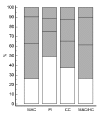Approaching the diagnosis of growth-restricted neonates: a cohort study
- PMID: 20122167
- PMCID: PMC2830965
- DOI: 10.1186/1471-2393-10-6
Approaching the diagnosis of growth-restricted neonates: a cohort study
Abstract
Background: The consequences of in utero growth restriction have been attracting scholarly attention for the past two decades. Nevertheless, the diagnosis of growth-restricted neonates is as yet an unresolved issue. Aim of this study is the evaluation of the performance of simple, common indicators of nutritional status, which are used in the identification of growth-restricted neonates.
Methods: In a cohort of 418 consecutively born term and near term neonates, four widely used anthropometric indices of body proportionality and subcutaneous fat accretion were applied, singly and in combination, as diagnostic markers for the detection of growth-restricted babies. The concordance of the indices was assessed in terms of positive and negative percent agreement and of Cohen's kappa.
Results: The agreement between the anthropometric indices was overall poor with a highest positive percent agreement of 62.5% and a lowest of 27.9% and the kappa ranging between 0.19 and 0.58. Moreover, 6% to 32% of babies having abnormal values in just one index were apparently well-grown and the median birth weight centile of babies having abnormal values of either of two indices was found to be as high as the 46th centile for gestational age (95%CI 35.5 to 60.4 and 29.8 to 63.9, respectively). On the contrary, the combination of anthropometric indices appeared to have better distinguishing properties among apparently and not apparently well-grown babies. The median birth weight centile of babies having abnormal values in two (or more) indices was the 11th centile for gestational age (95%CI 6.3 to 16.3).
Conclusions: Clinical assessment and anthropometric indices in combination can define a reference standard with better performance compared to the same indices used in isolation. This approach offers an easy-to-use tool for bedside diagnosis of in utero growth restriction.
Figures

Similar articles
-
Diagnostic markers in combination improve the identification of growth-restricted neonates.Early Hum Dev. 2011 Aug;87(8):549-54. doi: 10.1016/j.earlhumdev.2011.04.011. Epub 2011 May 10. Early Hum Dev. 2011. PMID: 21561727
-
Relationship between customised birthweight centiles and neonatal anthropometric features of growth restriction.BJOG. 2002 Jun;109(6):658-62. doi: 10.1111/j.1471-0528.2002.01367.x. BJOG. 2002. PMID: 12118644
-
Clinical assessment of nutritional status at birth.Indian Pediatr. 1998 May;35(5):423-8. Indian Pediatr. 1998. PMID: 10216623
-
Diagnostic performance of third-trimester ultrasound for the prediction of late-onset fetal growth restriction: a systematic review and meta-analysis.Am J Obstet Gynecol. 2019 May;220(5):449-459.e19. doi: 10.1016/j.ajog.2018.09.043. Epub 2019 Jan 8. Am J Obstet Gynecol. 2019. PMID: 30633918
-
Fetal growth regulation and intrauterine growth retardation.J Pediatr Endocrinol Metab. 2004 Mar;17 Suppl 3:435-43. J Pediatr Endocrinol Metab. 2004. PMID: 15134304 Review.
Cited by
-
Comparative Assessment of Fetal Malnutrition by Anthropometry and CAN Score.Iran J Pediatr. 2012 Mar;22(1):70-6. Iran J Pediatr. 2012. PMID: 23056862 Free PMC article.
-
[Fetal malnutrition assessment program].Zhongguo Dang Dai Er Ke Za Zhi. 2020 Dec;22(12):1273-1278. doi: 10.7499/j.issn.1008-8830.2007122. Zhongguo Dang Dai Er Ke Za Zhi. 2020. PMID: 33327997 Free PMC article. Chinese.
References
-
- Miller HC, Hassanein K. Diagnosis of impaired fetal growth in newborn infants. Pediatrics. 1971;48:511–522. - PubMed
-
- Lee PA, Chernausek SD, Kokken-Koelega AC, Czernichow P. International small for gestational age advisory board consensus development conference statement: Management of short children born small for gestational age. Pediatrics. 2003;111:1253–1261. - PubMed
-
- Hindmarsh PC, Geary MPP, Rodeck CH, Kingdom JCP, Cole TJ. Intrauterine growth and its relationship to size and shape at birth. Pediatr Res. 2002;52:263–268. - PubMed
Publication types
MeSH terms
LinkOut - more resources
Full Text Sources
Miscellaneous

